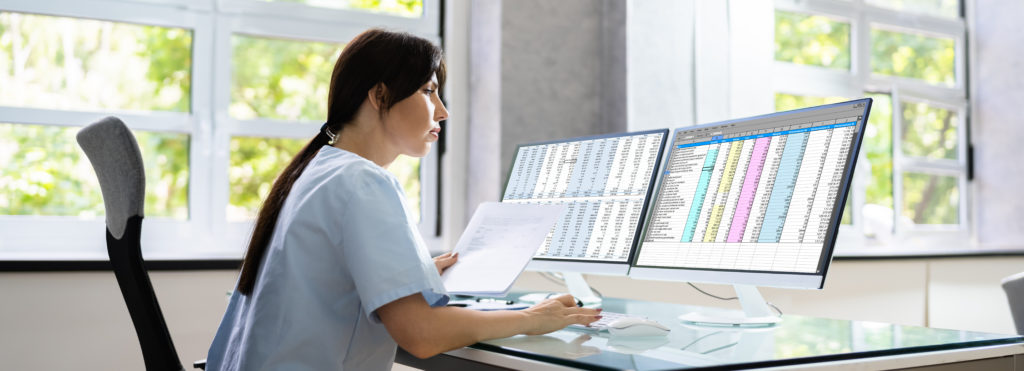Coding may seem complicated, but using codes for medical billing has become essential for all HealthCare organizations, making this skill set a trademark to running a successful medical practice. Medical Coding and Billing specialists are part of the backbone of HealthCare practices. These professionals ensure that patient information is processed correctly and insurance fees are handled promptly without delay. But what are these specialists faced with, and how complicated is it truly?
Medical Coding and Billing is a learned trade that can only be developed with practice. It’s not something that can be picked up in a single afternoon. At Montes HealthCare College, we offer a Medical Coding and Billing course that aims to train prospective students on the fundamentals of this profession. The Medical Coding and Billing industry certainly have many aspects to uncover, so we’ve outlined some of the basics below. If you’re interested in learning more, we welcome you to schedule a tour of our Gardena campus. Don’t wait! Start your career in HealthCare today.
I. Exploring Coding and Billing
Medical Coders and Billers follow separate processes with their own individual structures when compared to other back-office professionals, like Medical Assistants. Medical billing begins when a patient visits a medical office and is examined by a physician. The physician is responsible for taking thorough notes that are then reported by the Medical Coding and Billing specialist, utilizing the Electronic Health Record of the patient. Proper reporting is dependent on accurately assigning the medical services received with the proper billing code related to a diagnosis, procedure, chronic charge, and healthcare professional or facility code.
This Medical billing process is how healthcare organizations submit claims to payers and bill patients for their financial responsibility. A “Superbill,” which is known as an itemization of the services provided, can be generated by the Medical Coder and Biller. In turn, this allows providers to create claims for the services given during the patient visit. These processes ensure that medical services are properly reported and accurately billed.
II. Codes, Medical Coding, and What Billing Specialists Need to Know

You need to be aware of several code categories as a Medical Coding and Billing specialist. These are all covered during your education at Montes HealthCare College. Additionally, these fundamentals should also be reviewed regularly to ensure that reports maintain accuracy. Important code categories include:
- ICD-10 Diagnosis Codes – These codes describe a patient’s condition or injury. The industry uses the International Statistical Classification of Diseases and Related Health Problems, on its tenth revision (ICD-10) to capture diagnosis codes for billing purposes.
- CPT and HCPCS Procedure Codes – These types of codes and their modifiers indicate procedures performed by physicians during office visits.
- Charge Capture Codes – These codes indicate a standard set of charges for services performed. Charge capture codes may include procedure descriptions, time reference codes, departments involved in the medical service, as well as billable items and supplies.
- Professional and Facility Codes – These codes capture the physician and other clinical services delivered. Codes assigned for a particular professional/facility also help in distinguishing the services for billing purposes. These codes stem from the documentation in a patient’s electronic medical record.
III. The Two Billing Categories
In addition to having several Medical Coding categories, our prospective students should also be aware of the different types of medical billing. These can be broken into two main categories: front and back-end.
- Front-end Billing
This category makes reference to the billing process, which begins when a patient registers at the office or hospital after scheduling an appointment. At this time, the patient must fill out information forms, as these are used to verify the patient health plan and request for services. Essentially, the front-end billing process involves informing patients of any costs they are responsible for. Ideally, these costs are collected as copayments at the start or end of the patient’s office visit. Once a patient’s visit is complete, medical coders work with their medical records and begin to convert the information into billable codes.
- Back-end Billing
The Back-end billing side involves transmitting claims to the payers. These payers can be state-provided health insurance like Medicare or Medicaid, which requires Medical Coders and Billers to fill a CMS-1500 form. It may also be transmitted to a different third-party payer who may use another CMS format. A superbill is meant to be compiled in order to itemize a detailed list of the services offered, properly. Then, during the claim preparation stage, the Medical Coder & Biller “scrubs” claims. The process of “Scrubbing” is used to ensure that all of the information is correct and accurately indicated. Maintaining accuracy is essential to guarantee that the office is properly compensated, and patients are charged a fair bill.
IV. Learn More at Montes HealthCare College in Gardena, CA
The Medical Coding and Billing field is comprised of many moving parts. Additionally, professional Medical Coders and Billers are in high demand. Thankfully, learning how to navigate these moving parts can be done with the help of our exceptional Academic Staff at Montes HealthCare College.
At MHCC, we will facilitate all the tools and guidance that you will need to excel as a professional in the Medical Coding and Billing field. If you’re ready to begin your journey, get in touch with one of our admissions counselors, and schedule a tour of our Gardena campus.
New Class is starting soon!
You can reach us by calling (310) 436-7000 or clicking HERE.

